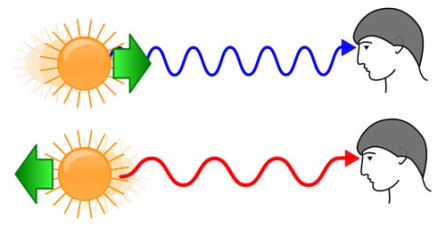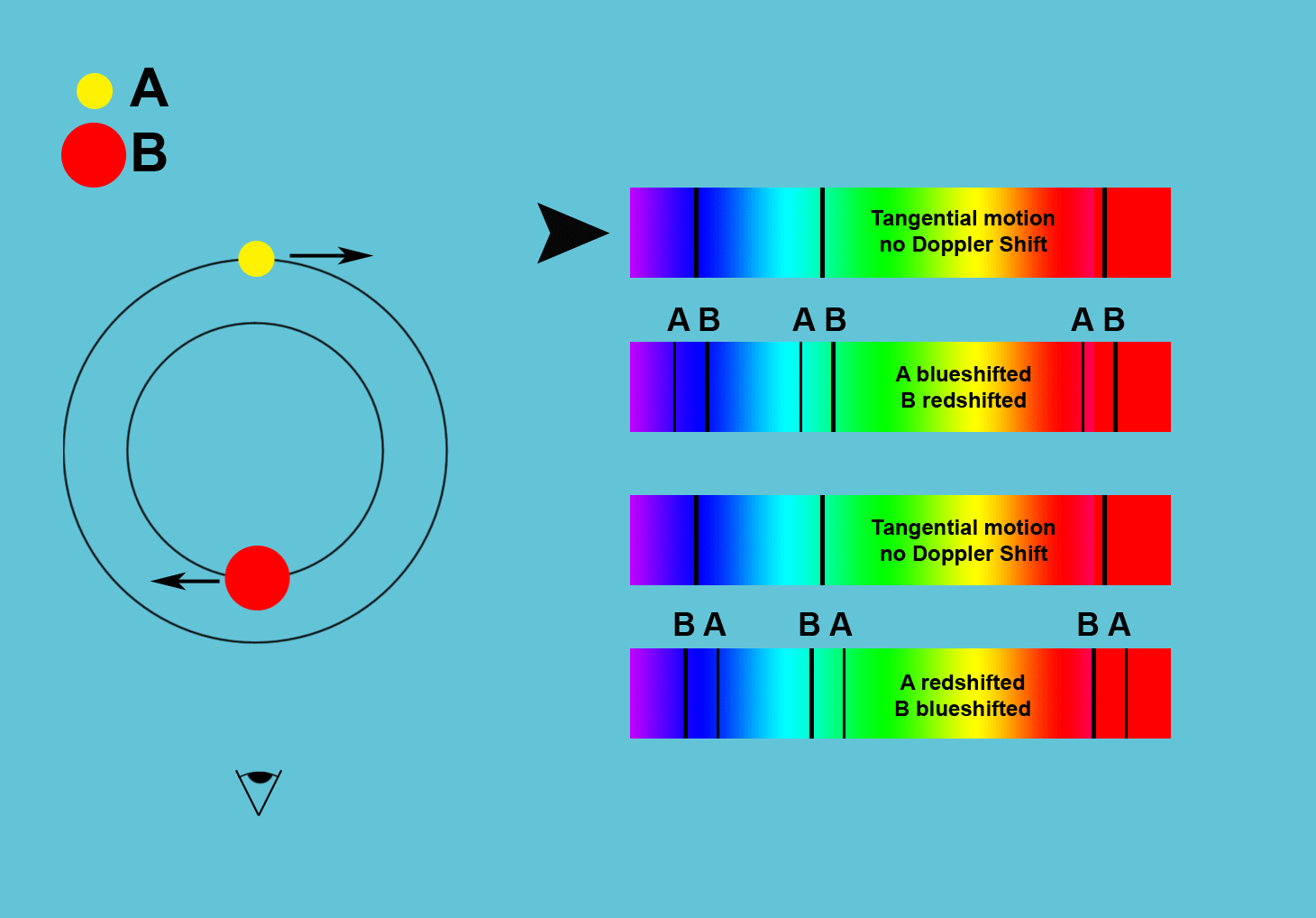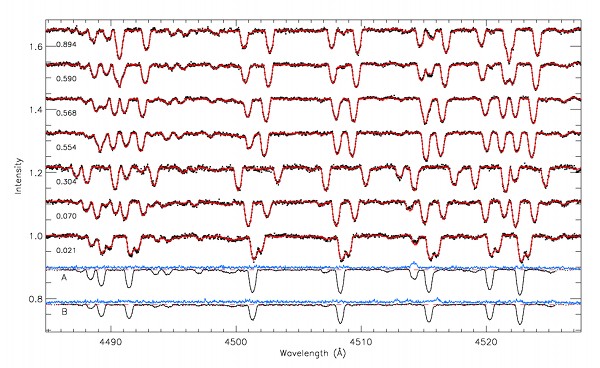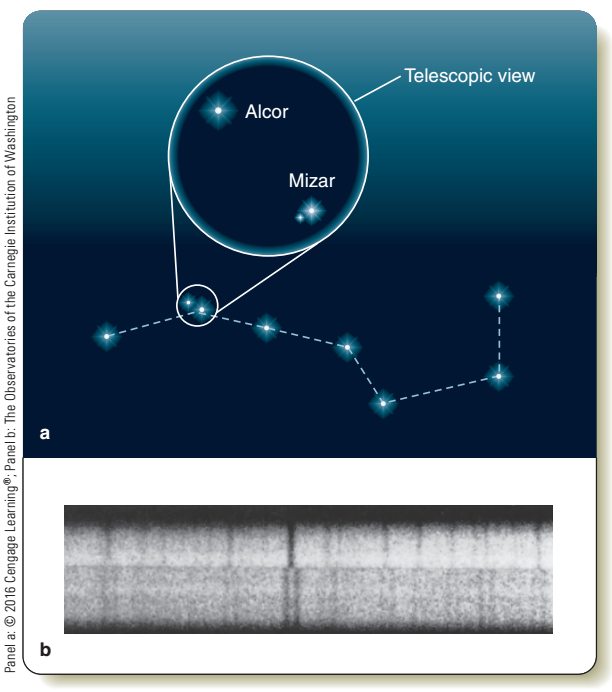
Consider a solar system far different from our own. A solar system governed by two suns, and consisting of planets we can only dream of.
Would it surprise you to hear that, based on recent discoveries, that might actually be the norm?
The surroundings we grow up in determine our outlook on the world, and this is never more true than with our solar system. Our eight planets (though some would vehemently insist upon nine) and their parent star are all we know.
But what if I told you that most of the stars you see when you look up at the night sky have companions? And often, these companions are impossible to detect by visual means.
So how do we know they exist?
By looking at their spectra.

Wait a second…what are spectra again?
For those of you who missed my posts on stellar spectra or need a refresher, you’re looking at the single most important way to tell what a star is made of and what temperature it is—and from there, its spectral class and even luminosity class.
Essentially, stars produce radiation of every wavelength on the electromagnetic spectrum, a spectrum of all radiation in the universe. Visible light is only a tiny portion of it; the rest, our eyes didn’t evolve to see.
Materials in stars’ atmospheres block certain wavelengths, and not just on the visible spectrum. This creates tiny but dramatic drops in the intensity of those wavelengths, and astronomers can measure this.
On the visible spectrum, it creates little black lines where those wavelengths never reached our instruments. That’s what you’re seeing up above.
But in order to understand what the spectra up above are telling you about spectroscopic binaries, I need to explain something else: the Doppler effect.
The Doppler effect is a way to measure the motion of stars either towards or away from us.

Don’t let this diagram mislead you. It’s not trying to say that if a star is moving toward you, you see it as blue, and if a star is moving away from you, you see it as red. The Doppler effect has to do with spectral lines—which is why I mentioned them.
The Doppler effect doesn’t change an object’s color at all. But it does make the spectral lines produced by the star’s material shift a little bit, to the left or to the right.
Because it doesn’t matter if a spectrum has red or blue on the left or the right, these shifts are called redshift and blueshift.

The reason for the shift? When an object moves towards us, it creates the illusion that the wavelengths of light it’s emitting are getting shorter, and our eyes perceive shorter visible wavelengths as more blue.
And when an object moves away from us, it creates the illusion that those same wavelengths are getting stretched…which our eyes perceive as more red.
Now let’s take a look at a spectrum taken from a spectroscopic binary system.

This diagram demonstrates a couple of important things. For one, see how each star in this animated binary system has its own orbit? They’re both orbiting their center of mass, which is the balance point of their system.
Note that the observer’s point of view is below the animation, so that when the pointer indicates the first spectrum, both stars are moving sideways to our line of sight. Because the Doppler effect only registers movement towards or away from the observer, there is no Doppler shift on the spectrum. The spectral lines remain where they are.
But take note of the second spectrum. Here, the larger red star is moving away from us. It will be redshifted on the spectrum. The opposite will happen to the smaller yellow star—it’s moving towards us, so it’ll be blueshifted.
And look what happens to the spectrum. Those spectral lines move apart, revealing that they were produced by two different stars but just overlapped when there was no Doppler shift.
But more specifically, the spectral lines produced by Star A shift towards the blue, and those produced by Star B shift toward the red. Just as the Doppler effect predicts.
When we get to the third spectrum, both stars are once again moving sideways from our perspective. There is no Doppler shift. But on the fourth spectrum, we see the second step but in reverse. Now A is redshifted, and B is blueshifted.
Of course, spectral lines produced by actual stars are rarely this cut and dry…

Here, you’re seeing the same thing happening.
But now we’re looking at a graph, instead of a rainbow. Dips in the graph show you the same thing as dark lines. Just as dark lines tell you that light has been blocked, dips show you that light has dramatically decreased in intensity. Same thing.
The Doppler shifts might be a little less obvious here, especially to the untrained eye. If you’re having trouble seeing it, focus specifically at the middle two columns of spectral lines (dips).
Notice how at the very bottom of the graph, each of those columns forms only one spectral line? But look up higher—slowly, they split apart, though it just looks like a two-humped camel at first. By the fifth set up, the spectral lines have clearly separated.
What’s happening here? Even though you don’t see a rainbow on this graph, imagine one end of it as blue and the other as red. As the dips in the graph split, one is being blueshifted and the other is being redshifted.
You’re seeing two stars in a spectroscopic binary system move towards and away from you…just as astronomers do.
Yesterday, I introduced you to visual binary systems, binary systems that can be seen as two separate stars through a telescope or even with the naked eye. One in particular that we got to meet was Mizar and Alcor of the Big Dipper.

Mizar and Alcor can be seen as two separate stars by the naked eye, even though they’re gravitationally bound like any binary star system. However, there’s more to their story.
What I didn’t tell you in that post is that they aren’t just part of a binary system. Mizar is in itself a binary star, consisting of Mizar A and Mizar B, which can be separated with a telescope.

And that’s not all. A spectroscopic binary is a star system that can only be seen as more than one star by looking at its spectrum; through a telescope, no matter what we do or how good our equipment is, it will always look like one star.
And it would appear that Mizar A itself is just that.

The spectrum in part b of this diagram is that of Mizar A, and it’s actually two spectra of this star taken at different times. Notice how in the top spectrum, we see one spectral line bold and clear, but in the bottom one, it’s split in two?
Upon closer inspection, you’ll even find that all of the spectral lines in this image are split in two on the bottom spectrum. That’s of course due to the Doppler effect.
What this reveals is that Mizar A itself is a spectroscopic binary. It’s more than likely we will never “split” Mizar A with a telescope. But its companion star is clearly there, in the lines of its spectrum.
Spectroscopic binaries aren’t the only type of binary we can study. Next up, I’ll introduce you to eclipsing binary systems.
You really could teach this stuff.
LikeLiked by 1 person